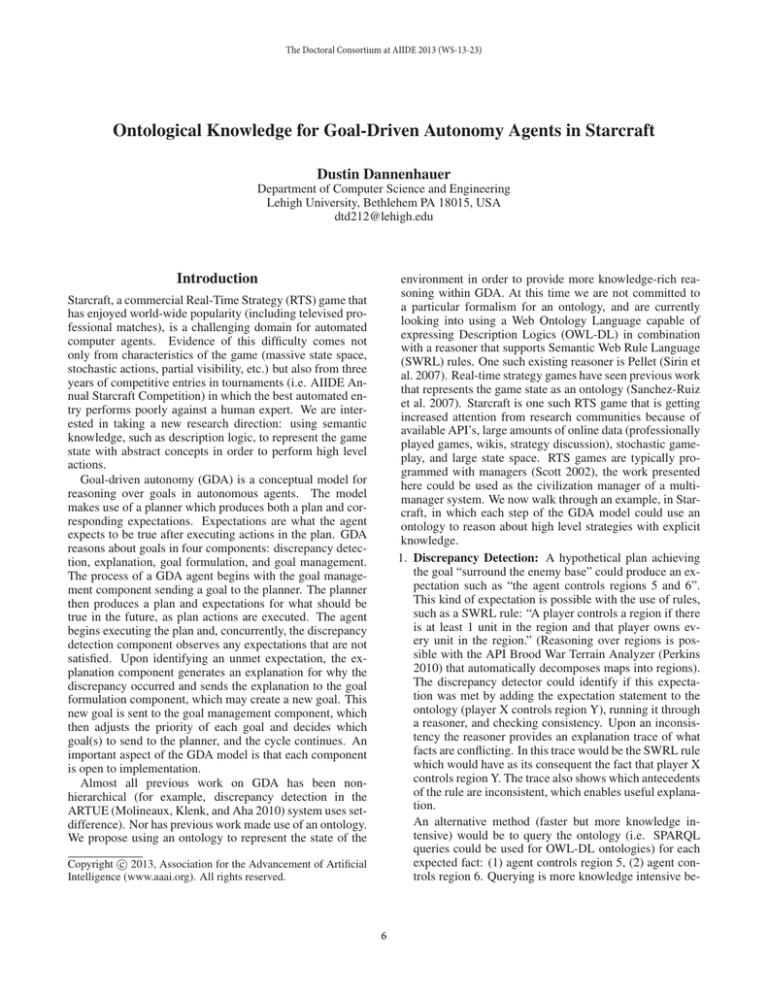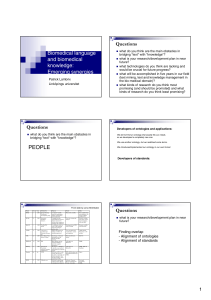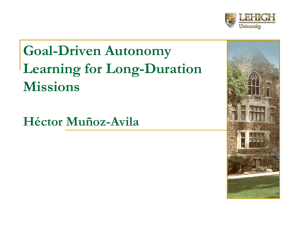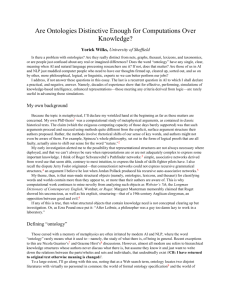
The Doctoral Consortium at AIIDE 2013 (WS-13-23)
Ontological Knowledge for Goal-Driven Autonomy Agents in Starcraft
Dustin Dannenhauer
Department of Computer Science and Engineering
Lehigh University, Bethlehem PA 18015, USA
dtd212@lehigh.edu
Introduction
environment in order to provide more knowledge-rich reasoning within GDA. At this time we are not committed to
a particular formalism for an ontology, and are currently
looking into using a Web Ontology Language capable of
expressing Description Logics (OWL-DL) in combination
with a reasoner that supports Semantic Web Rule Language
(SWRL) rules. One such existing reasoner is Pellet (Sirin et
al. 2007). Real-time strategy games have seen previous work
that represents the game state as an ontology (Sanchez-Ruiz
et al. 2007). Starcraft is one such RTS game that is getting
increased attention from research communities because of
available API’s, large amounts of online data (professionally
played games, wikis, strategy discussion), stochastic gameplay, and large state space. RTS games are typically programmed with managers (Scott 2002), the work presented
here could be used as the civilization manager of a multimanager system. We now walk through an example, in Starcraft, in which each step of the GDA model could use an
ontology to reason about high level strategies with explicit
knowledge.
1. Discrepancy Detection: A hypothetical plan achieving
the goal “surround the enemy base” could produce an expectation such as “the agent controls regions 5 and 6”.
This kind of expectation is possible with the use of rules,
such as a SWRL rule: “A player controls a region if there
is at least 1 unit in the region and that player owns every unit in the region.” (Reasoning over regions is possible with the API Brood War Terrain Analyzer (Perkins
2010) that automatically decomposes maps into regions).
The discrepancy detector could identify if this expectation was met by adding the expectation statement to the
ontology (player X controls region Y), running it through
a reasoner, and checking consistency. Upon an inconsistency the reasoner provides an explanation trace of what
facts are conflicting. In this trace would be the SWRL rule
which would have as its consequent the fact that player X
controls region Y. The trace also shows which antecedents
of the rule are inconsistent, which enables useful explanation.
An alternative method (faster but more knowledge intensive) would be to query the ontology (i.e. SPARQL
queries could be used for OWL-DL ontologies) for each
expected fact: (1) agent controls region 5, (2) agent controls region 6. Querying is more knowledge intensive be-
Starcraft, a commercial Real-Time Strategy (RTS) game that
has enjoyed world-wide popularity (including televised professional matches), is a challenging domain for automated
computer agents. Evidence of this difficulty comes not
only from characteristics of the game (massive state space,
stochastic actions, partial visibility, etc.) but also from three
years of competitive entries in tournaments (i.e. AIIDE Annual Starcraft Competition) in which the best automated entry performs poorly against a human expert. We are interested in taking a new research direction: using semantic
knowledge, such as description logic, to represent the game
state with abstract concepts in order to perform high level
actions.
Goal-driven autonomy (GDA) is a conceptual model for
reasoning over goals in autonomous agents. The model
makes use of a planner which produces both a plan and corresponding expectations. Expectations are what the agent
expects to be true after executing actions in the plan. GDA
reasons about goals in four components: discrepancy detection, explanation, goal formulation, and goal management.
The process of a GDA agent begins with the goal management component sending a goal to the planner. The planner
then produces a plan and expectations for what should be
true in the future, as plan actions are executed. The agent
begins executing the plan and, concurrently, the discrepancy
detection component observes any expectations that are not
satisfied. Upon identifying an unmet expectation, the explanation component generates an explanation for why the
discrepancy occurred and sends the explanation to the goal
formulation component, which may create a new goal. This
new goal is sent to the goal management component, which
then adjusts the priority of each goal and decides which
goal(s) to send to the planner, and the cycle continues. An
important aspect of the GDA model is that each component
is open to implementation.
Almost all previous work on GDA has been nonhierarchical (for example, discrepancy detection in the
ARTUE (Molineaux, Klenk, and Aha 2010) system uses setdifference). Nor has previous work made use of an ontology.
We propose using an ontology to represent the state of the
c 2013, Association for the Advancement of Artificial
Copyright Intelligence (www.aaai.org). All rights reserved.
6
A motivation for using ontologies is that STRIPS representations are too limited to represent events that happen
in the real world (or complex domains), more structured
representations are needed in order to capture more complex constraints (Gil and Blythe 2000). While ontologies
are knowledge-rich and more expressive than STRIPS, a recurring problem is knowledge engineering. Most work on
GDA has assumed that GDA knowledge is given by the user
or domain expert, aside from the work done by Jaidee et
al. where expectations and goal formulation are learned
via reinforcement learning (Jaidee, Muñoz-Avila, and Aha
2011a),(Jaidee, Muñoz-Avila, and Aha 2011b)) and Weber
et al. where goals are formulated from cases made from
Starcraft game traces (Weber, Mateas, and Jhala 2010). To
reduce the knowledge engineering burden of creating ontologies, we propose using automated text-extraction tools
to build initial ontologies. For self-contained domains such
as Starcraft, a significant amount of textual information is
available online which could be used to build an ontology.
There has been previous work that demonstrated extracting
text from the manual for the RTS game Civilization II to
create rules based on the strategy described in the manual
(Branavan, Silver, and Barzilay 2011). Additionally, there
are automated tools for creating semantic web ontologies
which may be able to be used to create initial ontologies
from online resources (Laender et al. 2002).
cause there is no immediate connection between a missing
fact (missing expectation) and its corresponding explanation (there is no inconsistency trace). SPARQL queries
may be justified for primitive expectations (such as counting the number of fighting units we have) because there is
no connecting explanation in the ontology (no rule where
the consequence is that the agent owns a unit). Here we
focus on reasoning over the ontology and detecting expectations via inconsistencies with corresponding traces.
2. Explanation: Continuing the example above, the explanation component could identify which part of the rule
was not satisfied via the trace. If there were no units in
the region, then a valid explanation could be that somehow our units were not able to travel to the region (perhaps there is an enemy force between the agent’s units
and the target region). But if the other antecedent was
inconsistent, i.e., not all the units were ours, that would
be evidence for a different explanation, perhaps that the
enemy controls the target region.
3. Goal Formulation: Either explanation would provide
rich knowledge for the goal formulation component. If
the explanation was that agent’s units were not able to
travel to the region, the new goal could be to send different types of units (i.e. flying vs. ground), or take a
different path. If the explanation was that the enemy controlled the target region, then perhaps the new goal could
be to send a more powerful force, with different units.
Unit types could be chosen to be those specifically effective at defeating the enemy units that destroyed the first
force. Which units are effective against other units can be
represented in the ontology.
4. Goal Management: The goal management component
would take the goals produced from the goal formulation
component and adjust the priority of the current goal. Perhaps the new information in the ontology warrants abandoning the “surround the enemy base” goal and instead
pursuing the newly suggested goal from the goal formulation component.
Most previous GDA systems reason at the unit level of
a game (i.e. unit U3 is at (5,6)). While data at the unit
level is important, it lacks the more abstract knowledge (i.e.
data at a region level) that is needed to produce high-level
strategies, such as those employed by humans. Expert human Starcraft players are admired for both their low-level
unit micromanagement abilities as well as their high level
strategic abilities. Ontologies allow for the representation of
both low-level unit details and high level details, including
knowledge that bridges these different levels. The ability
to reason at the region level (such as labeling a region has
“unknown”, “contested”, “owned by the agent” or “owned
by the enemy”) opens the door for higher level strategies.
The kinds of strategies we describe here are more abstract
than the strategies used in EISBot (Weber, Mateas, and Jhala
2011). EISBot’s strategy selection component determines
what types of units to produce and which upgrades to research. Our strategies reason about where and how to attack
the enemy (which also includes which unit types and upgrades to pursue).
Research Plan
We plan to manually design an ontology with the help of a
domain expert for a GDA agent that can play Starcraft. This
will most likely require new GDA algorithms to integrate
such an ontology into the GDA agent. We will then use
others’ strategies for extracting text to automatically build
ontologies from text data. We expect the GDA agent with
the hand crafted ontology will outperform the agents with
automatically created ontologies (due to the likelihood that
automatically extract ontologies will have more errors). A
future research task will be to explore techniques to refine
automatically learned ontologies.
The following is the research plan:
1. Perform a literature overview on GDA research (done)
2. Investigate Starcraft as a domain for experimentation
(done)
3. Investigate use of ontologies in the context of GDA (done)
4. Implement a system exhibiting the results of (3) and test
it in Starcraft (in progress)
5. Perform a literature review of ontology extraction
6. Investigate automated extraction techniques of ontologies
from textual/web information sources
7. Apply (6) on Starcraft strategy online resources
8. Investigate learning techniques to refine ontologies from
episodic knowledge
9. Perform an empirical evaluation on Starcraft comparing:
GDA with hand-crafted ontologies vs. with automatically
extracted ontologies
7
Weber, B. G.; Mateas, M.; and Jhala, A. 2010. Case-Based
Goal Formulation. In Proceedings of the AAAI Workshop on
Goal-Driven Autonomy.
Weber, B. G.; Mateas, M.; and Jhala, A. 2011. Building
Human-Level AI for Real-Time Strategy Games. In Proceedings of the AAAI Fall Symposium on Advances in Cognitive Systems, 329–336.
10. Perform empirical evaluations on Starcraft comparing
GDA with ontologies against previous tournament winners and/or skilled human players
Progress
We have currently looked into taking a case-based reasoning approach to the knowledge engineering burden required to use scoring algorithms from IBM’s Watson (Ferrucci 2012) for the goal management/selection component
of GDA (Dannenhauer and Muñoz-Avila 2013). This relies
on the presence of oracles (possibly humans) and uses evidence scoring algorithms to rank goals in order to choose
the best one. We are currently working towards creating an
expert given ontology for Starcraft as well as a GDA implementation of a Starcraft bot for step 4 in our research plan.
References
Branavan, S.; Silver, D.; and Barzilay, R. 2011. Learning to
Win by Reading Manuals in a Monte-Carlo Framework.
Dannenhauer, D., and Muñoz-Avila, H. 2013. Case-Based
Goal Selection Inspired by IBM’s Watson. In Case-Based
Reasoning Research and Development. Springer. 29–43.
Ferrucci, D. A. 2012. Introduction to This is Watson. IBM
Journal of Research and Development 56(3.4):1–1.
Gil, Y., and Blythe, J. 2000. How Can a Structured Representation of Capabilities Help in Planning. In Proceedings
of the AAAI–Workshop on Representational Issues for Realworld Planning Systems.
Jaidee, U.; Muñoz-Avila, H.; and Aha, D. W. 2011a. CaseBased Learning in Goal-Driven Autonomy Agents for RealTime Strategy Combat Tasks. In Proceedings of the ICCBR
Workshop on Computer Games, 43–52.
Jaidee, U.; Muñoz-Avila, H.; and Aha, D. W. 2011b. Integrated Learning for Goal-Driven Autonomy. In Proceedings
of the Twenty-Second international joint conference on Artificial Intelligence-Volume Volume Three, 2450–2455. AAAI
Press.
Laender, A. H.; Ribeiro-Neto, B. A.; da Silva, A. S.; and
Teixeira, J. S. 2002. A Brief Survey of Web Data Extraction
Tools. ACM Sigmod Record 31(2):84–93.
Molineaux, M.; Klenk, M.; and Aha, D. W. 2010. GoalDriven Autonomy in a Navy Strategy Simulation. In AAAI.
Perkins, L. 2010. Terrain Analysis in Real-Time Strategy
Games: An Integrated Approach to Choke Point Detection
and Region Decomposition. In AIIDE, 168–173.
Sanchez-Ruiz, A.; Lee-Urban, S.; Munoz-Avila, H.; DiazAgudo, B.; and Gonzalez-Calero, P. 2007. Game AI
for a Turn-based Strategy Game with Plan Adaptation and
Ontology-based Retrieval.
Scott, B. 2002. Architecting an RTS AI. AI Game Programming Wisdom 2.
Sirin, E.; Parsia, B.; Grau, B. C.; Kalyanpur, A.; and Katz,
Y. 2007. Pellet: A practical OWL-DL reasoner. Web Semantics: science, services and agents on the World Wide
Web 5(2):51–53.
8






